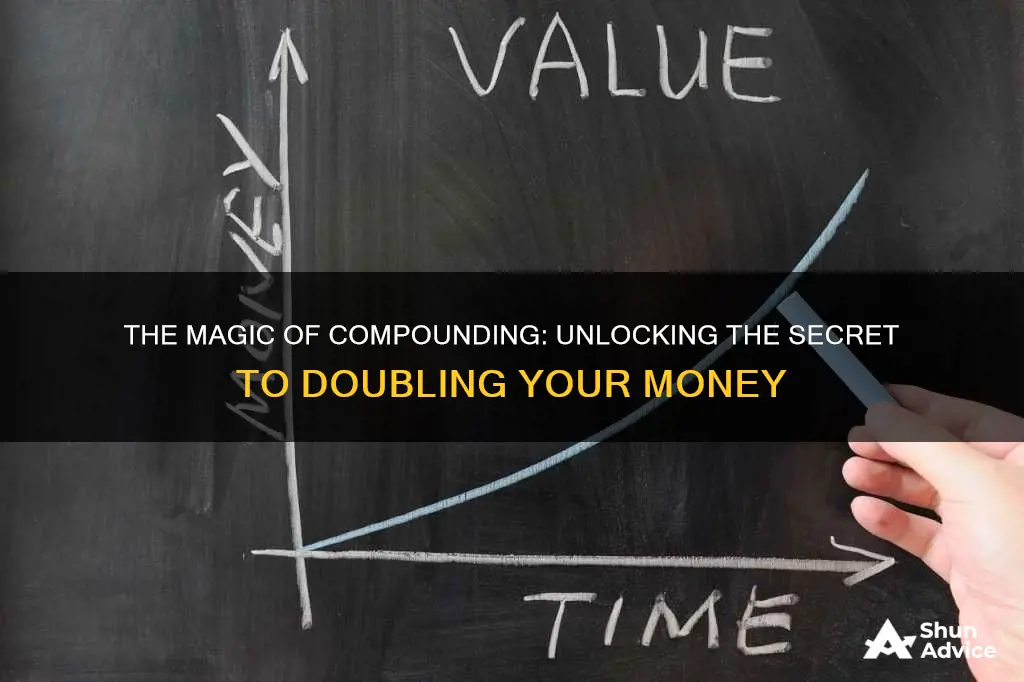
The Rule of 72 is a formula used to estimate how long it will take for an investment to double in value, based on its rate of return. The formula is simple: divide 72 by the interest rate to get a rough estimate of how long it will take for your investment to double. For example, if you have a 6% interest rate, it will take approximately 12 years to double your investment (72/6 = 12). This rule is a simplified version of a more complex compound interest calculation and is reasonably accurate for interest rates between 6% and 10%.
| Characteristics | Values |
|---|---|
| Rule of 72 | 72 / 6 = 12 years |
| Rule of 72 (months) | 72 / 0.5 = 144 months |
| Doubling Time Formula (years) | 11.58 years |
| Doubling Time Formula (months) | 138.98 months |
| Logarithmic Formula | T = ln(2) / ln(1+.06) |
What You'll Learn
- The Rule of 72: a formula to estimate how long an investment will take to double
- Doubling Time formula: calculates the time required to double an investment
- Compounded monthly: the rate needs to be expressed as a monthly rate, not an annual rate
- Continuous compounding: the natural log of 2 divided by the rate of return
- Logarithmic formula: a more accurate formula to calculate the time for an investment to double

The Rule of 72: a formula to estimate how long an investment will take to double
The Rule of 72 is a formula used to estimate how long an investment will take to double in value, assuming a fixed annual rate of return. It is calculated by dividing 72 by the annual interest rate (or rate of return).
For example, if an investment scheme promises an 8% annual compounded rate of return, it will take approximately nine years (72 / 8 = 9) for the initial investment to double.
The Rule of 72 is a quick and simple method to determine the approximate time it will take for an investment to double. It is most accurate for interest rates ranging from 5% to 10%. For more precise calculations, the Rule of 69.3 can be used, which involves dividing 69.3 by the rate of return.
The Rule of 72 can also be used to estimate the rate of return required for an investment to double within a certain time frame. For example, if you want to double your investment in 5 years, divide 72 by 5, indicating that you need to earn approximately 14.4% interest annually (72 / 5 = 14.4).
The Rule of 72 is a useful tool for investors to quickly gauge the potential of an investment and is often taught to beginners as it is easy to understand and calculate. It is a simplified version of the compound interest calculation, providing a close approximation.
The Rule of 72 has its origins in Luca Pacioli's 1494 mathematics book, "Summa de Arithmetica". Despite its simplicity, the methodology is quite accurate within a reasonable range.
Time is Money: The Power of Investing Early for Retirement
You may want to see also

Doubling Time formula: calculates the time required to double an investment
The Doubling Time formula is used in finance to calculate the length of time required for an investment or the amount of money in an interest-bearing account to double. This formula is also known as the Rule of 72.
The formula is:
> {\displaystyle T_{d}=t{\frac {\ln(2)}{\ln(1+{\frac {r}{100}})}}\approx t{\frac {70}{r}}}
Where Td is the doubling period (time it takes for the object to double in number), t is the time in years, and r is the growth rate.
For example, if you have an annual growth rate of 6%, the doubling time is 12 years (72/6 = 12).
It's important to note that the Rule of 72 is a simplified version of a more complex compound interest calculation. The Rule of 72 is a useful rule of thumb for estimating the doubling of an investment, but it is not entirely accurate. To get the exact doubling time, you would need to use the compound interest formula:
> A = P(1 + r)^t
Where A is the accrued amount, P is the principal investment, r is the interest rate per period, and t is the number of periods.
The Rule of 72 can also be adjusted for greater accuracy when dealing with interest rates outside the 6%-10% range. For example, if the interest rate is 11%, you would add 1 to 72 to get 73 for greater precision.
The Rule of 72 is also useful for quick mental calculations and is often taught to beginner investors as it is easy to understand and calculate.
Fear of Losing Money Keeps People from Investing
You may want to see also

Compounded monthly: the rate needs to be expressed as a monthly rate, not an annual rate
The Rule of 72 is a formula that can be used to estimate how long it will take for an investment to double in value, based on its rate of return. It is a simplified version of a more complex compound interest calculation. The rule can be applied to anything that grows at a compounded rate, such as investments, population, GDP, or inflation.
To use the Rule of 72, divide 72 by the interest rate to calculate how long it will take to double your money on an investment. For example, if you invest at a rate of 6% per year, it will take 72/6 = 12 years to double your money.
The Rule of 72 is most accurate for interest rates that fall between 6% and 10%. For rates outside this range, the rule can be adjusted by adding or subtracting 1 from 72 for every 3 points the interest rate diverges from 8%.
The Rule of 72 is a useful rule of thumb for quick mental calculations, but it is not always precise. For a more accurate estimate, a logarithmic formula can be used:
> T = ln(2) / ln (1 + (r / 100))
Here, 'T' is the time for the investment to double, 'ln' is the natural log function, and 'r' is the compounded interest rate. For example, with a 6% rate of return, the formula would be:
> T = ln(2) / ln(1+.06)
This calculation gives a result of 11.9 years, which is closer to the actual time than the 12 years estimated by the Rule of 72.
When calculating the time it takes for an investment to double, it is important to note that the rate used in the formula must be expressed in the same time period as the desired result. For example, if you want to calculate the number of months it takes to double your money in an account that is compounded monthly, the formula requires the monthly rate, not the annual rate. The monthly rate can be found by dividing the annual rate by 12. Using the monthly rate in the formula will give the number of months it takes to double the money, not the number of years.
For example, if you have an investment that earns 6% per year, compounded monthly, the annual rate must be divided by 12 to get the monthly rate. So, the 6% annual rate becomes 0.5% per month. Using the Rule of 72, 72/0.5 = 144 months, or 12 years. This is the same result as using the annual rate in the formula, but it gives the answer in months rather than years.
Alternatively, the annual percentage yield or effective annual rate can be used in the formula, which for a 6% rate compounded monthly, would be 6.168%. Using this rate in the formula also returns a result of 11.58 years.
Quantum Computers: The Next Investment Boom
You may want to see also

Continuous compounding: the natural log of 2 divided by the rate of return
The Rule of 72 is a simplified formula that calculates how long it will take for an investment to double in value, based on its rate of return. The formula is: Results = natural log(2) / rate per period.
The Rule of 72 is not precise, but it is a quick way to get a useful ballpark figure. It is most accurate for rates of return of about 5% to 10%.
The Rule of 72 can be leveraged in two ways:
- Years To Double: 72 / Expected Rate of Return
- Expected Rate of Return: 72 / Years To Double
The Rule of 72 can be applied to anything that grows at a compounded rate, such as population, macroeconomic numbers, charges, or loans. For example, if the gross domestic product (GDP) grows at 4% annually, the economy will be expected to double in 72 / 4% = 18 years.
The Rule of 72 applies to cases of compound interest, not simple interest. Simple interest is determined by multiplying the daily interest rate by the principal amount and by the number of days that elapse between payments. Compound interest is calculated on both the initial principal and the accumulated interest of previous periods of a deposit.
Continuous compounding uses a natural log-based formula to calculate and add back accrued interest at the smallest possible intervals. The distance between compounding periods is so small (smaller than even nanoseconds) that it is mathematically equal to zero.
The natural logarithm is the amount of time needed to reach a certain level of growth with continuous compounding. The natural log of 2 is equal to 0.693, and after dividing both sides by the interest rate, the formula becomes: 69.3 / r% = n.
By multiplying the numerator and denominator on the left-hand side by 100, you can express each as a percentage: 69.3 / r% = n becomes 69.3 / r = n x 100.
Continuous compounding is used to show how much a balance can earn when interest is constantly accruing. This allows investors to calculate how much they expect to receive from an investment earning a continuously compounding rate of interest.
Retirement Investments: Strategies for a Secure Future
You may want to see also

Logarithmic formula: a more accurate formula to calculate the time for an investment to double
The Rule of 72 is a popular formula used to estimate the number of years required for an investment to double at a given annual rate of return. It is calculated by dividing 72 by the interest rate. For example, at a rate of 6% interest, it will take approximately 12 years to double the money (72/6 = 12). This formula is a simplified version of a more complex logarithmic formula and provides a reasonably accurate estimate.
The Rule of 72 is especially useful for quick mental calculations and is often taught to beginner investors. It can also be used to estimate the rate of return needed for an investment to double within a certain time frame. For instance, if you want to double your investment in 5 years, you would divide 72 by 5, which indicates that you need to earn an interest rate of 14.4% annually (14.4 x 5 = 72).
While the Rule of 72 is convenient and practical, it is essential to understand that it is a simplification of a more intricate logarithmic equation. The precise formula for calculating the exact doubling time for an investment with a compounded interest rate of 'r' per period is:
Logarithmic Formula:
\[ T = \frac{ln(2)}{ln(1 + \frac{r}{100})}\]
In this formula, 'T' represents the number of periods (usually years) required for the investment to double, and 'r' is the interest rate per period.
Let's use this formula to calculate the time it would take for an investment with a 6% annual interest rate to double:
\[ T = \frac{ln(2)}{ln(1 + \frac{6}{100})} = \frac{ln(2)}{ln(1.06)} \]
Using a calculator, we find that 'T' is approximately equal to 11.5 years. This result is slightly more accurate than the estimate provided by the Rule of 72, which was 12 years.
The Rule of 72 is most accurate for interest rates ranging from 6% to 10%. When dealing with rates outside this range, adjustments can be made by adding or subtracting from 72 for higher precision.
Retirement Savings: Why the Reluctance?
You may want to see also
Frequently asked questions
The Rule of 72 is a formula that estimates the number of years required for an investment to double at a given annual rate of return. You can divide 72 by the interest rate to get a rough estimate of how long it will take to double your money.
The Rule of 72 is not entirely precise but provides a quick and useful ballpark figure. It is most accurate for interest rates ranging from 6% to 10%.
Compounding frequency refers to the number of compounding periods in a year. It answers the question of how often interest is added to the principal each year. For example, annual compounding has a frequency of one, quarterly compounding has a frequency of four, and monthly compounding has a frequency of twelve.
Simple interest is calculated only on the initial sum of money, whereas compound interest includes interest on both the initial principal and the accumulated interest.
The calculation of the Rule of 72 in Matlab is done by running the command "years = 72/return," where "return" is the rate of return on investment, and "years" is the result.







